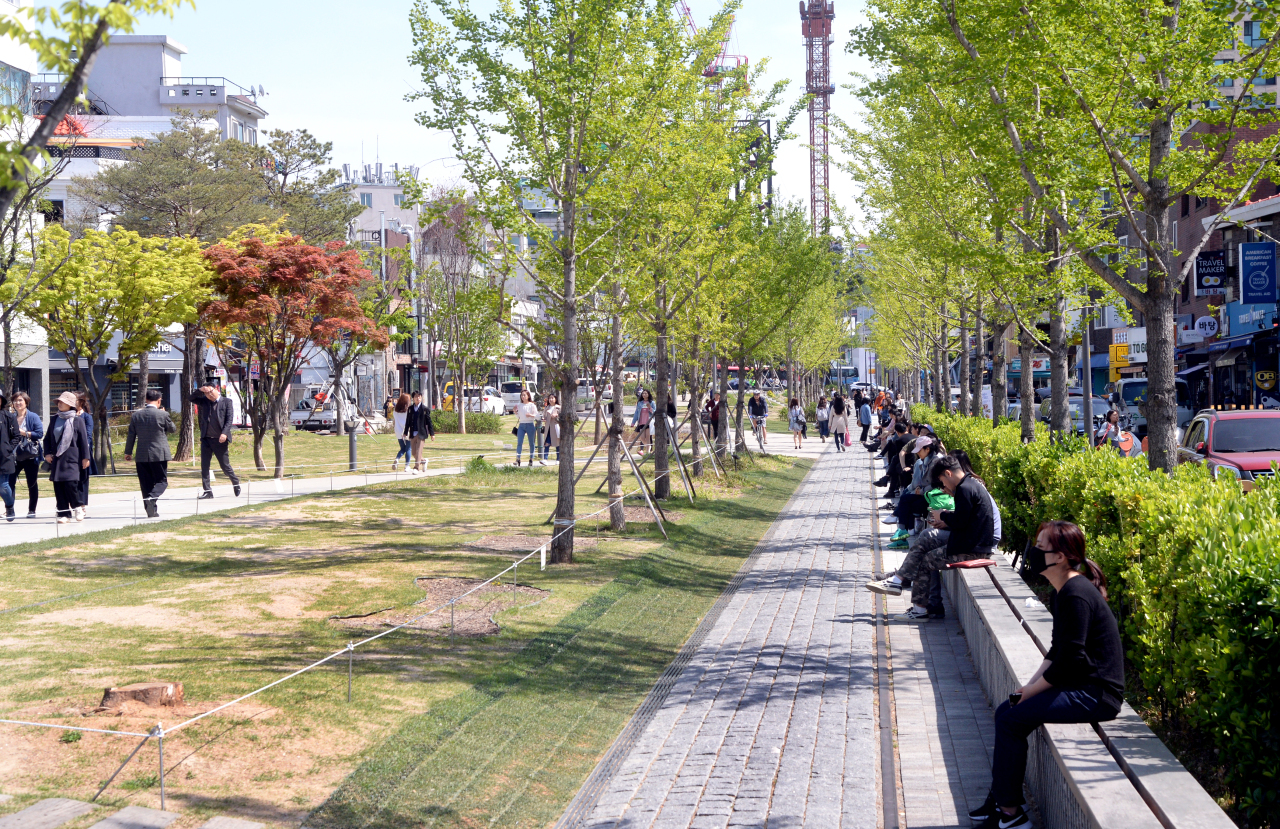
In Seoul’s affluent neighborhood of Hannam-dong, where top celebrities and corporate big shots live, a bleak and desolate 28,197-square-meter plot of land lies barren and untouched.
Fenced off with barbed wires, the land -- the size of four soccer fields -- has been off limits to residents for decades.
Records dating back to the 1940s show authorities reserved the land for a public park. In reality, the dusty plot stands as a legacy of the turbulent times Korea has been through, with the land’s occupier changing from the Japanese colonial army to the US Forces Korea.
As the USFK’s Yongsan Garrison moved out of Seoul and vacated the area, the Seoul Metropolitan Government put forward a plan to finally convert it into what has been tentatively named the Hannam Neighborhood Park.
But as the year 2021 draws to an end with no progress made on the necessary land acquisition, a big question mark hangs over the future of the project.
Too expensive for a park?
The neighborhood surrounding the site has become a posh town of lavish villas that includes Nine One Hannam and Hannam The Hill, where some members of the K-pop juggernaut BTS live. In November, the site’s book value surpassed 460 billion won ($390 million).
For environmentalists, the increased monetary value of the land is not a reason to shelve the project.
In high-density cities like Seoul, open green spaces have immense benefits, providing many amenities and enhancing people’s quality of life, they say.
They argue that the city government should just stop dragging its heels and swiftly take the ownership of the land. A further delay will only increase the cost, they say.
“Located between Namsan and the Han River, the ecological value that the site holds is much greater than the expected profit from building homes in the area,” said Choi Young, an activist of the Korea Federation for Environmental Movement.
Choi Seung-hee of Forest for Life, a nonprofit organization raising public awareness on the benefits of healthy forests, stressed urban parks are needed more than ever before.
The risk of climate change-induced natural disasters in cities such as heat waves, heavy snowfall, and torrential rain has increased and it is important for cities to create resiliency in the face of such challenges, she said. “City parks and green spaces are essential for this.”
Not everyone agrees.
Like other projects that use taxpayers’ money, the park project needs to go through a new cost-benefit analysis, reflecting the increase in cost. They say the money could be spent elsewhere to bring greater and more direct benefits to citizens.
Choi Sun-ho, who has been running a real estate agency in the area since 2006, is among the skeptics.
“A more rational decision would be to build more houses instead of pouring such a large sum of money just for one park, which is not urgently needed,” he said.
He went on to point out that residents who wish to go for a walk or have a picnic can visit parks near Namsan or along the Han River. As the district has a large floating population, the park, if built, would be used more by strangers and residents would end up living with a maintenance headache, the realtor added.

Tangled in legal issues
Aside from concerns over costs, the Hannam park project has also been entangled in complex legal issues.
The property’s owner and conglomerate Booyoung Group has sued the city government for infringement of private property. It says it has no intention to give up on the land, which has ample potential for residential development.
Booyoung bought the land for 120 billion won ($101.8 million) in 2014 with a plan to construct luxury villas, a year before the land’s designation as a park site was due to expire.
Their investment was based on the 1999 Constitutional Court decision that unexecuted urban planning schemes violate the property right of land owners. The top court’s ruling paved the way for a vast area of reserve land, like the Hannam-dong plot, to be de-designated after 20 years of inaction.
The Seoul Metropolitan Government, determined not to lose the reserve land to developers, exerted its administrative power to re-designate it under another category.
It was a necessary decision to stop Seoul’s few remaining open spaces from turning into apartment complexes and shopping malls while it secures funding to buy them in phases, city officials said.
Last year saw a flurry of such re-designations.
By July, Seoul was set to have lost a total of 118.5 square kilometers of reserve land, or 132 sites, due to automatic revocation of their designations.
But about half, or 58.4 percent of the total, were re-designated. Authorities paid compensations or purchased another 20.7 percent, equivalent to about 24.5 square kilometers, to keep them as parks.
The remaining 20.9 percent, or a 24.8-square-kilometer area near Bukhansan, was taken over by the Ministry of Environment and incorporated into a national park.
Environmentalists speak highly of such actions.
“The city government protected urban parks by using financial and nonfinancial means. It was a forward-looking action for the future of the city,” said Choi of Forest for Life.
But the legal battles have continued, as landlords accuse Seoul of undermining the top court’s decision in favor of property rights.
The courts’ decisions on those cases have just begun to arrive, according to Kim Jae-yun, a lawyer at real estate law firm Myungkyung Seoul, who represents more than 100 land owner clients involving 15 parks including Maljukgeori Park in Yangjae-dong, Seocho-gu, and Sangdo Neighborhood Park in Sangdo-dong, Dongjak-gu.
“In general, my clients want revocation of the administrative act that restricts their land again with new designation as their expectation to receive compensation after 20 years of regulations vanished with it,” he said.
Waning interest
For the Hannam-dong plot, the city government’s plan, put forward in September last year, was to channel 180 billion won for the land acquisition in 2022.
With the land owner Booyoung showing no signs of giving up on the land, the city government is unlikely to succeed.
According to the proposed budget for next year, which is pending city council approval, the city has not allocated a penny for it.
The failure to secure a budget suggests the Hannam Neighborhood Park project has gone back to square one.
A city government official said a study on the feasibility of creating a park will begin soon, with a plan to be completed by June 2022.
“Depending on the result, the city will decide whether to draw up an extra budget for the project next year,” the official added.
In accordance with related rules, it must pay Booyoung two-thirds of the compensation money by June 2025 and complete the payment by 2027.
Plans to create new parks in Seoul began going downhill after the sudden departure of Seoul Mayor Park Won-soon, who died by suicide in July 2020. The former mayor was a vocal advocate of public parks and deplored reckless development in Seoul. He had clashed with the central government several times after refusing to free up Seoul’s “green belt” preservation areas for new housing projects.
Sitting Mayor Oh Se-hoon, who took office in April, sees Park’s policy as being too focused on “conservation and maintenance,” he told members of the Seoul Metropolitan Council on Nov. 18, criticizing the lack of balance between development and conservation.
Seoul’s spending on land compensation for park reserves plunged after peaking in 2020. That year, the city had a budget of 1 trillion won, and it was cut by half to 480 billion won this year. Next year, according to the annual budget plan, only 157.3 billion won will be set aside.
That falls far short of the 888 billion won needed to pay land owners who expressed their willingness to sell their land to the city in 2022. The city’s overall budget for next year is set to be its largest ever, at 44 trillion won.
Bills were introduced to the National Assembly in order to secure funds for land purchases by harnessing transportation, energy and environmental taxes and to provide tax relief to land owners, but none of them have reached the final vote.
Choi of Forest for Life says the central government should play a bigger role in preserving and protecting urban green spaces.
“The central government has viewed designated parks as potential development sites. It’s time for them to see it as a solution to climate change,” she said.
The Korea Federation for Environmental Movement’s Choi cited Mayor Oh’s own remarks that sustainable environment is one of the “most important determinants of urban competitiveness,” saying the city needs green spaces for its present and future generations.
“Making payment quickly is the most economical way for the city government as the land value keeps rising. If not, it is giving up on such public service,” the activist said.







![[From the Scene] Monks, Buddhists hail return of remains of Buddhas](http://res.heraldm.com/phpwas/restmb_idxmake.php?idx=644&simg=/content/image/2024/04/19/20240419050617_0.jpg&u=20240419175937)








![[From the Scene] Monks, Buddhists hail return of remains of Buddhas](http://res.heraldm.com/phpwas/restmb_idxmake.php?idx=652&simg=/content/image/2024/04/19/20240419050617_0.jpg&u=20240419175937)

![[KH Explains] Hyundai's full hybrid edge to pay off amid slow transition to pure EVs](http://res.heraldm.com/phpwas/restmb_idxmake.php?idx=652&simg=/content/image/2024/04/18/20240418050645_0.jpg&u=20240419100350)

![[Today’s K-pop] Illit drops debut single remix](http://res.heraldm.com/phpwas/restmb_idxmake.php?idx=642&simg=/content/image/2024/04/19/20240419050612_0.jpg&u=)